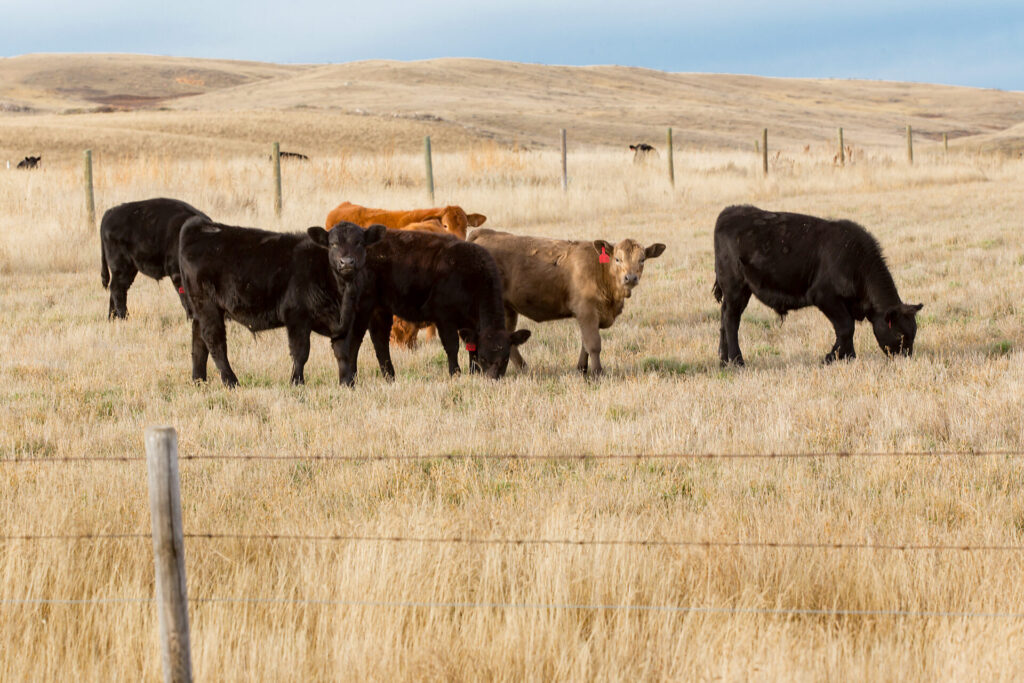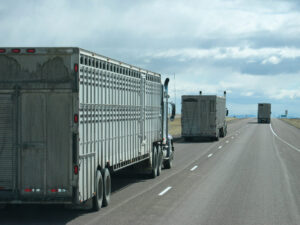Do Transport Rest Stops Put Calf Health at Risk? 🎙️
This article written by Dr. Reynold Bergen, BCRC Science Director, originally appeared in the October 2023 issue of Canadian Cattlemen magazine and is reprinted on BeefResearch.ca with permission of the publisher.
CLICK THE PLAY BUTTON TO LISTEN TO THIS EPISODE:
Listen to more episodes on BeefResearch.ca, Spotify, Apple Podcasts, Amazon Music or Podbean.

The Canadian Food Inspection Agency revised the Transportation of Animals regulations a few years ago. Among other things, the revised regulations require longer and more frequent feed, water and rest stops during long-haul transport. Over the past few years, this column has summarized three research trials conducted by Karen Schwartzkopf-Genswein’s team at Agriculture and Agri-Food Canada’s Lethbridge Research Station. Those results repeatedly demonstrated that rest stops during long-haul transport do not provide measurable benefits for recently weaned beef calves.
In fact, new data suggests that those rest stops may pose a risk to calves. Nasal samples were collected and tested for respiratory bacteria during the three trials. The first results from those analyses have just been published (“Auction market placement and a rest stop during transportation affect the respiratory bacterial microbiota of beef cattle”; doi: 10.3389/fmicb.2023.1192763).
What They Did
160 freshly-weaned (not preconditioned) crossbred steer calves from a single ranch were split into two groups of 80 calves. One group went to an auction mart overnight (with feed and water) and was put through the ring the next day before being trucked to the research feedlot. A second “ranch direct” group went directly to the research feedlot. Commercial truckers loaded the calves (at the auction mart or the ranch), hauled them for 36 hours and unloaded them. At this point, half of the auction mart and half of the ranch direct calves were immediately reloaded and hauled for another four hours to the research feedlot. The other half of each subgroup were rested for eight hours, then reloaded and hauled the last four hours to the research feedlot.
Deep nasopharyngeal swabs were collected from 48 calves (12 from each of the four treatment groups) when they were unloaded at the research feedlot and one, three, six and 28 days after arrival. These samples were tested for the presence of bacteria that can have a protective effect on respiratory health (e.g., Lactobacillus), bacteria that can break down protective mucus and impair respiratory health (e.g., Streptococcus), and groups of bacteria that are directly involved in bovine respiratory disease (BRD; e.g., Histophilus, Mannheimia, Pasteurella and Mycoplasma).
What They Learned
Ranch direct vs. auction mart calves: The bacteria most often associated with BRD (e.g., Mycoplasma, Pasteurella, Histophilus and Mannheimia) were more common in the calves that had gone through the auction mart than in the calves that went directly from the ranch to the feedlot. That’s a bit surprising, given these research calves were not comingled with calves from other sources. At most, they shared a fenceline and waterbowl with other calves – sort of like a cattle rest facility.
Rested vs. unrested calves: Auction mart calves that were unloaded for an eight-hour feed, water and rest break carried fewer protective Lactobacillus than unrested auction mart calves each time they were sampled. Rested ranch direct calves carried less Lactobacillus than unrestedranch direct calves when they arrived at the feedlot and 28 days later.
Potentially adverse Streptococcus bacteria were much more common in rested auction mart calves than in unrested auction mart calves at four out of the five sampling points. Rested ranch direct calves also carried more Streptococcus than unrested ranch direct calves at every sampling time.
Rest stops often increased the abundance of the groups of bacteria associated with BRD. Rested auction mart calves carried more Mycoplasma than unrested auction mart calves at four of the five sampling time points. Rested ranch direct calves carried slightly fewer Mycoplasma than unrested ranch direct calves at all five time points.
Rested auction mart calves carried slightly fewer Pasteurella than unrested auction mart calves at all five time points, but rested ranch direct calves carried slightly more Pasteurella than unrested ranch direct calves at all five sampling times.
Rested auction mart calves carried more Histophilus than unrested auction mart calves on day 1, 3 and 6 after feedlot arrival. Rested ranch direct calves carried more Histophilus than unrested ranch direct calves on day 3 after feedlot arrival. Rested auction mart calves carried more Mannheimia than unrested auction mart calves the day after arrival, while rested ranch direct calves carried more Mannheimia than unrested ranch direct calves at all five measurement points.
So What Does This Mean…To You?

Although animal numbers and BRD treatment rates were too low (less than 6%) to detect significant differences between the auction and ranch-direct groups, the microbiology results suggest that a rest stop during long-distance transport may increase the risk of BRD in newly weaned beef calves. An eight-hour rest stop reduced the numbers of good (protective) bacteria and increased the numbers of bacteria that can compromise respiratory health and/or can cause BRD.
Bottom line: Canadian research had already shown that rest stops during long haul transport don’t benefit newly weaned beef calves. This new research suggests that rest stops may increase the risk of BRD and potentially the need for preventative or therapeutic antimicrobial use (increased treatment not seen in this study). We’ll bring you the results from the other two trials as they become available.
The Beef Cattle Research Council is funded by the Canadian Beef Cattle Check-Off. The BCRC partners with Agriculture and Agri-Food Canada, provincial beef industry groups and governments to advance research and technology transfer supporting the Canadian beef industry’s vision to be recognized as a preferred supplier of healthy, high-quality beef, cattle, and genetics.
Click here to subscribe to the BCRC Blog and receive email notifications when new content is posted.
The sharing or reprinting of BCRC Blog articles is typically welcome and encouraged, however this article requires permission of the original publisher.
We welcome your questions, comments and suggestions. Contact us directly or generate public discussion by posting your thoughts below.